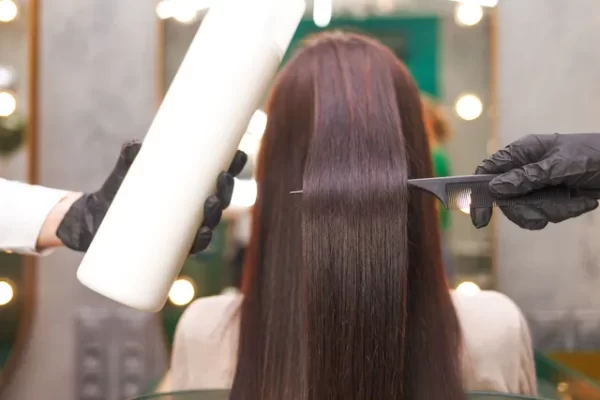Hair Treatment for Damaged Hair
We’re all a little guilty of occasionally doing bad things to our mane in our quest for great hair days. It can be difficult to prevent the damage that results from whitening your brunette hair to the point of breaking or from using a flat iron regularly to obtain glass hair.
The ultimate beauty is radiant, healthy hair, yet regular exposure to chemicals, heat styling, environmental contaminants, and improper hair care techniques can leave our locks dull and damaged. Don’t worry, there’s still hope! Rejuvenating and rehabilitating your hair at home is a breeze with a hair treatment for damaged hair. It doesn’t matter what type of damage you’ve experienced, this is one of the simplest ways to give your hair a fresh start. Explore effective strategies and products to revive damaged hair and promote overall hair health.
Understanding Hair Damage
It’s important to comprehend the many forms of hair damage before beginning any treatments. Frizz, breaking, split ends, and dryness are typical forms. Determining the particular problems your hair is having will enable you to customize your treatment plan for the best outcomes. To understand how hair becomes damaged, it helps first to understand the structure of your hair. Several layers arrange these proteins in different ways, creating a structure that gives your hair its unique look, feel, and behavior. The strand consists of three different cell layers, each with its unique arrangement. The cortex, composed of protein cells resembling rods and contains melanin, the pigment responsible for hair color, covers the medulla. The cuticle is the outermost layer. It comprises flat, thin cells that overlap, resembling roof tiles.
Causes of Damaged Hair
Damaged hair strands can result from various sources, most of the time from multiple ones together. These are the top three reasons that hair damage occurs.
The process of bleaching: More than three shades of hair lightening necessitate larger amounts of peroxide or bleach, which increases the risk of hair damage, according to the American Academy of Dermatology (AAD). Dryness results from bleaching because it removes moisture from hair, and frequent bleaching can cause more severe damage to the hair, such as split ends and breakage.
The Heat Look: Hot tools are great for creating contemporary looks like a huge blowout, but they’re not the best for hair, especially if we use them too often. Frequently, the temperatures at which our hot tools operate surpass the range at which we typically cook meals, potentially severely scorching your hair strands. Utilizing them sparingly is acceptable, but it’s best to combine them with healthy hair habits, such as applying heat protectants and utilizing the lowest temperature possible.
The shade of Hair: In addition to causing damage like brittle hair and dehydration, permanent hair color can also dry out your strands. As a result, it’s advisable to leave your hair for six to eight weeks to heal in between hair color treatments. The AAD recommends opting for a deeper hue than your current color as it is gentler on your hair and eliminates the need for bleach. Explore various effective hair treatments for damaged hair, helping you achieve healthier and more vibrant locks.
Protein Treatments
The term “protein hair treatment” refers to a category of cosmetic products that focus on repairing and strengthening damaged hair. Because of the fact that 95% of hair is composed of protein, it is terrible that everything we do to our hair, including washing and brushing, produces changes to the protein composition. Therefore, you can understand what occurs when chemical procedures, colouring, bleach, and heat damage are involved. Your ability to safeguard your hair with protein replenishment will increase in proportion to the degree to which you are able to stop damage from progressing. Protein treatments are designed to replenish and restore the protein structure of the hair, which would result in an improvement in the hair’s overall health, as well as its strength and flexibility.
Sulfate-Free Shampoos
The natural oils in your hair can be significantly preserved by switching to sulfate-free shampoos. Sulfates can remove these oils, which increases damage and dryness. Pick a mild, sulfate-free shampoo to wash your hair without doing more damage.
Botox Hair Treatment
The purpose of the cosmetic hair treatment known as hair Botox is to revitalise and refresh the hair, resulting in hair that is silkier, more shiny, and simpler to be managed. An application of a filler, such as keratin, is applied to the hair fibres during a deep conditioning operation. Treatments for hair loss with Botox do not include the administration of injections. Instead, a chemical that conditions your hair is administered directly to the individual strands of your hair. The treatment can be received at a hair salon or the products can be purchased for use at home. Both of these choices are available to the customer
Hot Oil Treatment for Hair
The application of warm or heated oils to the scalp and hair is the practice that constitutes the hot oil therapy for hair, which is a trending and very effective method of hair care. Indulging in a hot oil treatment is not only a luxurious spa ritual, but it is also a therapy that provides your hair and scalp with a profound amount of nourishment. If you have ever been curious about the factors that contribute to the success of this time-honored practice or if you are considering giving it a shot for the very first time, you have arrived to the perfect location. In this all-encompassing guide, we will discuss the wonders of hot oil treatment, as well as its benefits, and we will also answer some concerns that are usually asked in order to guarantee that you get the most out of this revitalising experience.
K18’s hair mask is similar to a leave-in conditioner in how it’s used. You shampoo your hair, forgo traditional conditioner, then use a pump (or more, depending on hair length and density) of K18 on towel-dried hair, before styling. The only crucial instruction is to evenly distribute the product and allow it to work for four minutes on the hair before styling. Adhering to the manufacturer’s specified application procedure is crucial for achieving the best results. Apply it to damp hair, let it dry for a set time, then rinse and condition as usual.
Frequently Asked Questions about Hair Treatment for Damaged Hair
1. I have Damaged Hair; can I Still Color or Style it?
The best course of action when attempting to restore damaged hair is to stay away from more chemical treatments and heavy heat styles. If you must color or style your hair, use kinder products and methods, and make sure to give it additional attention and hydration.
2. What Impact does Nutrition have on Hair Health?
For hair to be healthy, a person must eat a balanced diet rich in vitamins, minerals, and proteins. Deficits in some nutrients can aggravate hair damage. Foods high in omega-3 fatty acids, vitamin E, and biotin can help to maintain healthy hair.
3. Should Damaged Ends be Trimmed?
Split ends must be trimmed to stop additional harm. Getting regular haircuts every 6 to 8 weeks will help keep your hair looking and feeling its best.
4. Can I Stop Hair Damage in the Future?
Yes, you can assist in avoiding future damage to your hair by using high-quality products that are appropriate for your hair type, minimizing heat styling, following a healthy hair care routine, and preserving your hair from environmental damage.
5. Which Hair Treatments Work Well for Damaged Hair?
Damaged hair might benefit from deep conditioning treatments, hair masks, and oil treatments to help hydrate and nourish it. Treatments with proteins can help make the hair shaft stronger. Healthy hair can also be achieved by using sulfate-free products and avoiding heat styling.
6. How Frequently Should I Treat my Damaged Hair with Hair Treatments?
The kind of treatment and the extent of the damage determines how frequently treatment is needed. Weekly deep conditioning sessions and monthly protein treatments are both possible. Avoid over-treating your hair as this may cause more problems.
7. Exist any Natural Cures for Hair Damage?
Yes, natural treatments like egg masks, avocado, coconut oil, and olive oil can help damaged hair get the moisture and nutrients it needs. Results, however, can differ, therefore it’s important to select remedies according to the particular requirements of your hair.
8. What harms hair?
Using excessive heat during styling, undergoing chemical treatments like coloring or perming, overusing hair products, exposure to harsh weather conditions, and neglecting hair care can all contribute to hair damage.
9. How can I Determine Whether my Hair is Harmed?
Split ends, frizz, dullness, brittleness, and trouble styling are indications of damaged hair Unhealthy or scratchy hair could indicate damage.
10. Is it Possible to Heal Damaged Hair?
While it may not be possible to fully repair damaged hair, you can enhance the quality of your hair and prevent further damage by utilizing nourishing treatments, adhering to a proper hair care routine, and avoiding harmful habits.
Wrap-Up
In conclusion, obtaining and preserving a healthy and bright mane depends heavily on comprehending and resolving the issues behind damaged hair. While it may not be possible to fully repair hair damage, taking a proactive approach and tailoring a personalized hair care routine can significantly improve the condition of your hair. Regular trims, nourishing treatments, and a commitment to gentle styling practices contribute to the overall well-being of your hair. Using natural therapies, watching your nutrition, and avoiding heat and chemicals are key to healthy hair. Remember that holistic hair care cures and prevents damage, keeping your locks strong and bright.


Leave a Reply